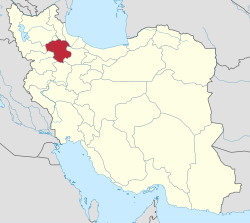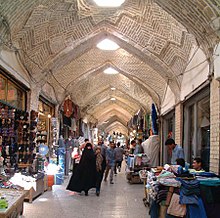Zanjan Province
Zanjan Province
استان زنجان | |
|---|---|
 Location of Zanjan Province in Iran | |
 Counties of Zanjan Province | |
| Coordinates: 36°40′30″N 48°29′04″E / 36.6751°N 48.4845°ECoordinates: 36°40′30″N 48°29′04″E / 36.6751°N 48.4845°E | |
| Country | |
| Region | Region 3 |
| Capital | Zanjan |
| Counties | 8 |
| Government | |
| • Governor | |
| • MP of Assembly of Experts | Mohammad Reza Doulabi |
| • Representative of the Supreme Leader | Ali Khatami |
| Area | |
| • Total | 21,773 km2 (8,407 sq mi) |
| Population (2011)[1] | |
| • Total | 1,015,734 |
| • Density | 47/km2 (120/sq mi) |
| Time zone | UTC+03:30 (IRST) |
| • Summer (DST) | UTC+04:30 (IRST) |
| Main language(s) | Persian (official) local languages: Azerbaijani (Majority) Tati Kurdish[2]Lori[3][4] |
| HDI (2017) | 0.771[5] high · 23rd |
Zanjan or Zangan Province (Persian: استان زنجان, Ostân-e Zanjân) is a Northwestern Iranian province hosting a more than a million people, largely Turkic speaking.[6] It is a mountainous province with close to 22,000 km2 of land placed in Iran's third region. Most of the inhabitants live in the two major cities of Zanjan and Abhar. One third of the population live in rural areas.[7][8]
Agriculture and industry
Agriculture is the principal occupation, and crops include rice, corn (maize), oilseeds, fruits, and potatoes. Poultry, cattle, and sheep are raised.[9] In the region Zanjan is known for its seedless grapes. Manufactures include bricks, cement, milled rice, and carpets. Chromium, lead, and copper are mined.[9] In the scientific world, Zanjan is the home of IASBS, one of the most productive research centers of the country.[10]
Zanjan is known for its handcrafts such as knives, traditional sandals called charoogh and malileh. Malileh is a handcraft made with silver wires. Zanjani artists make many things like decorative dishes and their special covers as well as silver jewelry. In ancient times, Zanjan was known for its stainless and sharp knives. But this tradition is gradually becoming extinct by introduction of Chinese knives to the market which are cheaper and better made. Many villagers today are traditional carpet weavers.
The province economy is benefiting from its location that connects central Iran to the northwestern provinces. The railway and highway that connects Iran's capital city Tehran to Tabriz, and Turkey passes through Zanjan Province.
Geography and climate

Zanjan has an area of 22,164 km2, occupying 1.34% of the Iranian territory. The average population density in Zanjan is 47 people per km². In the northwest of Iran, Zanjan covers joint borders with seven provinces: East Azerbaijan, West Azerbaijan, Hamadan, Kurdistan, Gilan, Ghazvin and Ardabil.
Shahrestan, or counties, in Zanjan Province are:
- Abhar County
- Ijrud County
- Khodabandeh County
- Khorramdarreh County
- Zanjan County
- Tarom County
- Mahneshan County
- Soltaniyeh County
Zanjan has a highland climate characterized by cold snowy weather in the mountains and moderate climate in the plains in wintertime. In the summers, the weather is warm. The average maximum temperature of Zanjan is around 27 °C, whereas the average minimum temperature stands at −19 °C. Meanwhile, the temperature rises to 32 °C on hot days; it drops to −27 °C on icy days.[9]
The average annual rainfall in the first month of spring stands at 72 millimetres, while in the second month of summer, it slips to a meagre 3.6 mm. The rate of humidity in the morning stands by average at 74% and at noon at 43%.[9]
The Zanjān River is the only major river in the region.[9]
Demographics
Azeris are the main ethnic group in the province followed by Tats. Cities and villages in southwest of Zanjan province have Kurdish population.[2] Like every other part of Iran the lingua franca is Persian.
History
In Ptolemy's Geography, the city is referred to as Aganzana. It is said that the Sassanid king Ardashir I of Persia, reconstructed the city and called it Shahin, but later it was renamed Zangan: the present name is the Arabicized form.
In past times Zanjan's name was Khamseh, which means "province with five tribes". Zanjan Province incorporates areas of the former Gerrus Province.
Colleges and universities

The Institute for Advanced Studies in Basic Sciences IASBS, in Zanjan city, is one of Iran's most distinguished upper-level education and research centers in the pure sciences. Zanjan is home to the University of Zanjan, Zanjan University of Medical Sciences, and Islamic Azad University of Zanjan.
References
- ^ Selected Findings of National Population and Housing Census 2011 Archived 31 May 2013 at the Wayback Machine
- ^ Jump up to: a b Government of Zanjan Province (Persian) Archived 22 July 2011 at the Wayback Machine.
- ^ :استان زنجان[dead link]
- ^ Fars News Agency: روستای خلیفه حصار و میلان
- ^ "Sub-national HDI – Area Database – Global Data Lab". hdi.globaldatalab.org. Retrieved 13 September 2018.
- ^ "استان زنجان بهترین گزینه سفر در نوروز 95". Khabaronline (in Persian). 18 March 2016.
- ^ "نگاهی به تغییرات جمعیتی استان زنجان در 40 ساله انقلاب اسلامی". اداره کل آموزش فنی و حرفه ای استان زنجان (in Persian). Retrieved 23 July 2021.
- ^ "معرفی استان".
- ^ Jump up to: a b c d e "Zanjan – region, Iran". Encyclopædia Britannica.
- ^ http://www.iasbs.ac.ir
External links
- Read more about zanjan in "Tebyan zanjan" Archived 6 January 2016 at the Wayback Machine
- University of Zanjan
- Islamic Azad University of Abhar
- Islamic Azad University of Zanjan
- Official website of Zanjan Governorship
- Iran Handcrafts & Handmade Archived 12 January 2007 at the Wayback Machine
- Sultaniyeh Dome Official website
- Zanjan University of Medical Sciences Archived 14 January 2018 at the Wayback Machine
- Zanjan City Information
| Wikimedia Commons has media related to Zanjan Province. |
- Zanjan Province
